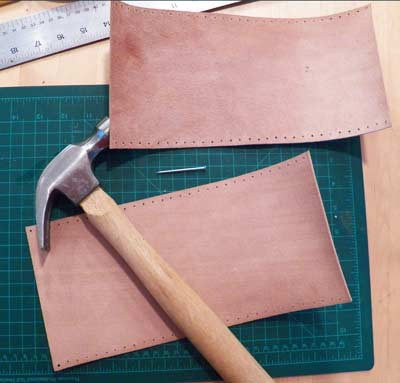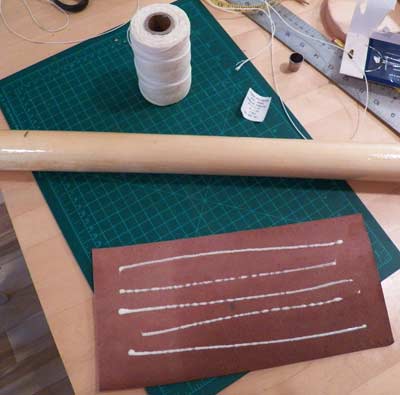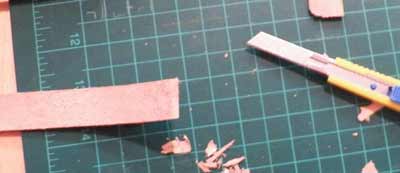
Leathering Oars
After several coats of varnish my new spoon shaped oars (guaranteed to make my Skerry boat skim over the water at lightning speed) are ready for leathering
Note that I did NOT varnish the handle. It makes it more comfortable to row and avoids blisters.
I bought these oars unfinished and sanded and varnished them. I had tried to make a pair of oars earlier but disaster struck and a shaft warped. One bad piece of wood.
The oars need protection where the oar locks rub against the oar. All kinds of sleeves and wrapping have been tried and they all seem to work. Some people just wrap a length of thin line on the shaft. There are also various plastic sleeves available such as NRS sells. I like leather mainly because I think it looks very nice on my boat. It also cushions the oar and make the rowing smoother feeling.
This is how I do it. I've leathered a few things including my mast and the leathering has held up and done its job so I know it works. The leather has lived on my boat for 3 years and has weathered to a nice dark colour.

Fist step is to decide where you want the leathering to be.
There is a formula that seems to works. You will need to know how wide your boat is where you intend the oars to be. My Skerry boat is about 54 inches wide at the rowing position.
Width of boat 54 inches / 2 = 27 inches. Add 2 inches to this = 29 inches. Make a mark on your oars in that spot measuring from the end of the handle.
This is where the CENTRE of the leather will be. Adjust this if you cross your hands quite a lot when you row or if you like to row with your hands far apart.

Measure the circumference of your oars where the leathering will be. Measure in more than one spot since the oar might not be the same size throughout. Mine has a 1/8 difference in diametre between the 2 ends of the leather.
I've seen many different kinds of leather used, mainly people just used old boots or pieces they had around. It all seems to work. IF your leather is old and brittle or tears easily then it might be too fragile for lacing. Try lacing a short piece and see it you can pull it tight. IF you can then it's strong enough.
I have some vegetable tanned leather about 3/16 of an inch thick. It has worked well on the mast so I have no problem using it. Some people recommend using oil tanned leather for oars. Many of the leathering kits for rowboats use "oak tanned leather". Sounds like vegetable tanned leather to me. Since my oars will be kept out of the water when stored and not allowed to soak I don't think there is any problem at all. I will be putting a finish on the oar leathering to protect it anyway. One advantage of vegetable tanned leather is that you can wet it, stretch it, then when it dries it will shrink making a nice tight finish.
Cut your leather the right width minus a small amount. In my case I removed an eight of an inch from the width. I know how much my leather stretches when wet. If you are worried then just measure and stretch a short strip. At the end you don't need your leather to be really tight to rip out the stitching. Only tight enough to stay on without shifting.

Here the leather has been cut to fit around the shaft of the oar (less about 1/8 inch). The length should be at least 9-10 inches if you can. I think mine is about 12 inches long. If your oars tapers a lot then cut a taper on your leather.
While you are cutting the oar leather, cut a couple of strips about 5/8 wide to wrap around the leather and create the stops.
Make a mark half way the length of the leather on the inside, to help position it on the oar. Remember you made a mark on the oar after you calculated where the leather should be.

Mark a series of stitching holes along the edges of the leather. Start measuring from the same end so they will line up. I made holes every 3/8 of an inch. The holes were a fat 1/8 of an inch from the edge.
I tried using a leather punch but the holes were nice but quite large. So I switched to a nail and that worked better. I punched all my holes and went back and re punched them from the back to make better holes easily seen from both sides.

You will need some sort of strong stitching material. I've used many different styles. The best is a slightly thicker twine that is very strong. It helps to wax it. This keeps it from tangling and makes it more manageable as you stitch. I'm using waxed polyester twine used to bind the end of lines. If your line is too thin it will tend to cut through the leather as you stitch and will be hard on your hands. If it's too thick it will be hard to lace and will stand proud of the leathering. If you only have a thinner thread, double it up. Remember to wax it to it does not tangle as easily.
Get a few strong needles. I've used curved needles and they work well but they are not necessary. You might break a couple as you stitch so have some spares.
I used about 6 feet of twine. It's annoying having to patch in more twine so longer is better than too short. Too long is harder to handle though.
I also use a pair of pliers to pull my thread through the hole. Since my twine is quite fat using pliers made it easier to pull stitches tight.
Soak your leather in warm water for a few minutes till it softens and can be stretched. IF you are using oil tanned leather I don't think you need to soak it because it is usually stretchier.
I like to add some glue. I'm using yellow carpenter's glue here. I've seen directions using rubber cement. I guess that would work if you were not stretching the leather. Carpenters glue stays soft until it dries so it does not interfere with lacing.
Don't pull the stitching too much, you just want a bit of tension to keep the sleeve on.
Align the mark on the oar to the centre mark on the leather.
It matters which way the stitching faces. It is preferable to have as little rubbing on the stitching as possible. This means the bottom, front and back will rub against the oarlock as you row, while the top will not rub as much. This means that the left and the right oar will have the stitching on different spots. I have spoon oars so it matters which one is which. In regular oars as long as the stitching is lined up with the corner of the oar blade there is no other concern.

Put a needle on both end of your twine.
To start, punch each needle into end holes of the leather and bring you thread back to the front and lace your leather all the way to the end. When you have done your first stitch you will have about 3 feet of twine on each needle Keep your lacing tight but don't tear your leather. It takes a bit of time but there is no rush.

The only thing to think about as you stitch is to keep always the order of the stitch the same and always cross the same way. It looks nicer.
At the end make a knot and stitch your ends under the lacing for a few inches to bury them. I usually put a small drop of glue on the knot, but I don't think it is essential. I don't know if if makes any difference on the stitching if you start from one side of the other.
Take a small hammer or mallet and tap your stitching all along to flatten it into the leather. Since your leather is wet it will dent in and the stitching will not stick out so much. You can use the back of a spoon to burnish it in also. Don't tap too hard otherwise you will dent your leather.

The next step is to install the leather collars, I think they are called buttons. This prevent the oarlocks from slipping off.
Taper the strip you cut earlier at both end so that there is not a big bump where it ends. The length of the strip is not critical. I measure a long enough piece so that my oarlock would not come off. I wanted my oarlock to stay on the oar. The collar can be thinner if you don't want to imprison your oarlock. The collar acts as a stop and prevents your oar from slipping off the oarlock and ending up in the water if you let go of it.
Put some glue along the strip and wind tightly along the handle edge of the leather you have just done. If you want you can put a few copper or brass tacks to hold it firmly. I use carpenter's glue but some people recommend rubber cement or even epoxy. I used string to hold it in place until the glue sets and will put only one tack to secure the very end. Because the end was tapered there is no bump where the wrapping ends.

DON'T FORGET TO PUT YOUR OARLOCKS ON THE OAR BEFORE YOU ATTACH THE WRAPPING!

The string has been removed and the buttons are solidly in place. The leather has dried and tightened up. I think I will get one tack and secure the end but at this point it is very solid.
After everything had dried I checked for any glue or dirt and cleaned it if necessary. My final step was to wax the leather. I used beeswax melted in a catfood tin. This I applied warm to the leather. It needs to be warm enough to soak in but not so hot as to burn. Be careful heating it, it can flame up or smoke. I used a small silicone brush I have for basting chicken in the kitchen. I quickly put the wax on and after it solidified I wiped off the excess. I then used my hair drier to make it soak in better. Some people just oil it. I tried to get as much wax in the leather as I could. It turned a lovely golden colour. All it needed then was a quick polish.
I can't wait to get to the water!
Note: it has now been 2 years since I have leathered my oars. The leathering has held up beautifully and done its job. I never got around to adding the copper tacks. I guess I'll do it this year.
Many suppliers sell leathering kits and if you don't have leather handy it's easier. If you have the supplies around it can be much less expensive.
I try to be accurate and check my information, but mistakes happen.
email me if you find mistakes, I'll fix them and we'll all benefit: Christine
Boat terms relating to rowing and rowboats
Tendercraft sells Oars in Toronto, that's where I got mine
Free plan to build wooden oars, canoe and kayak paddles. Some nice articles too.
Free Simple Oar Plans and construction instructions designed by Spark Geissler.
CLC oar leather kits and instructions.
Gartside boats leathering information
Wooden Boat article on Leathers. pdf format
American Traders.com leathering instructions.
With needle and palm blog article on new oar leathers.
Duckworks Magazine article on leathering a mast.
Teach Yourself to Sail
Ten Essential Knots
Marine Plywood Article.
DIY Launching Dolly for small boats
Making a birdsmouth mast
My sailmaking experiments
Carbon Fiber Characteristics
My Rowboat article
My Dory Page
Making a Puddle Duck Racer
Launching a stitch and glue Apple Pie Pram that I built as a tender for my Tanzer. The plans were free
Nautical Terms explained Boat building has its own language. Here are the most common boat hull terms explained.
Take apart and folding boats.
Small Print
This information is for general knowledge. It's not intended to replace plans. If you are not comfortable using powertools get help cutting and drilling.